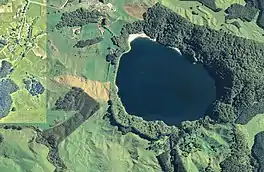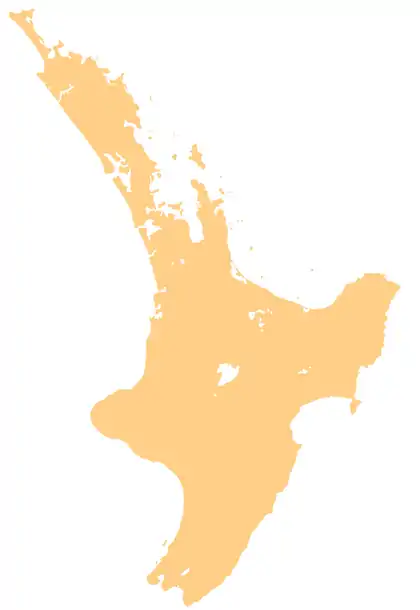| Lake Rotokawau | |
|---|---|
 Aerial view of Lake Rotokawau in 2018 | |
 Lake Rotokawau | |
| Location | Bay of Plenty, North Island |
| Coordinates | 38°04′24″S 176°22′46″E / 38.07331°S 176.37935°E |
| Type | maar lake |
| Primary inflows | Waimata Stream |
| Primary outflows | Waiohewa Stream |
| Catchment area | 2.23 km2 (0.86 sq mi) |
| Basin countries | New Zealand |
| Surface area | 0.52 km2 (0.20 sq mi) |
| Average depth | 43.7 m (143 ft) |
| Max. depth | 74 m (243 ft) |
| Surface elevation | 320 m (1,050 ft) |
Lake Rotokawau is a small volcanic lake 4.1 km (2.5 mi) east of Lake Rotorua in the Bay of Plenty region of New Zealand's North Island. The name is also used for lakes in the Kaipara District (Poutu Peninsula),[1] Chatham Islands,[2] on Aupouri Peninsula[3] and near Lake Waikare in Waikato.[4] Access is via Lake Rotokawau Road, from SH30 at Tikitere (Hell's Gate). The lake is owned and managed by Ngāti Rangiteaorere.[5]
Ecology
Lake Rotokawau is a small, oligotrophic lake; the best example of what many deep Rotorua lakes were once like. Koaro (Galaxias brevipinnis), banded kokopu (Galaxias fasciatus), long-finned eel (Anguilla dieffenbachia), short-finned eel (Anguilla australis), smelt (Retropinna retropinna) and common bully (Gobiomorphus cotidianus) live in the lake.[5] The catchment is roughly 65% forested and 25% in agriculture.
Geology
The lake is a maar lake,[6][7] formed by an explosion about 4,000 years ago, leaving cliffs of up to 90 m (300 ft) around the lake. The airfall eruptive volume was 0.7 km3 (0.17 cu mi) and covered an area with tephra of 70 km2 (27 sq mi) with a lava eruptive volume of 0.5 km3 (0.12 cu mi).[8][9] While the local rocks are rhyolite and pumice, with areas of alluvial sand and silt the formative eruption is one of only two, in a locality dominated by rhyolitic eruptions, recent basaltic fissure eruptions (the other is the 1886 eruption of Mount Tarawera).[10] Tephra from the eruption was dated at 3440 ± 70 years before 1950.[9] The eruption had the characteristics of a basaltic dike as there is a line of eruptive vents[8] almost at right angles to the usual vent alignments of the recently active Ōkataina Caldera. The maar crater is located almost exactly where this alignment intercepts a postulated continuation of the known fault defining the southern limit of the Tikitere Graben. The lake has one major inflow, the Waimata Stream, on the south side and also small geothermal springs on the north-west shore. The lake discharges via groundwater to the Waiohewa Stream, near Tikitere.[5]
References
- ↑ "Lake Rotokawau (Pöuto) Management Plan" (PDF). Northland Regional Council.
- ↑ "Lake Rotokawau, Chatham Islands – NZ Topo Map". NZ Topo Map. Retrieved 1 October 2017.
- ↑ "Lake Rotokawau, Northland". NZ Topo Map. Retrieved 26 October 2020.
- ↑ "Lake Rotokawau, Waikato – NZ Topo Map". NZ Topo Map. Retrieved 1 October 2017.
- 1 2 3 Pearson, Lisa; Hamilton, David; Hendy, Chris (July 2011). "Lake Rotokawau: Water quality and sediment study" (PDF). University of Waikato. Retrieved 28 August 2022.
- ↑ "R". www.geomarine.org.nz. Retrieved 26 October 2020.
- ↑ Bruce W Hayward (July 2019). "The Campaign to Save Crater Hill Continues" (PDF). Retrieved 28 August 2022.
- 1 2 Beanland, Sarah (1981). The Rotokawau eruption (Thesis).
- 1 2 Froggatt, P. C.; Lowe, D. J. (1990). "A review of late Quaternary silicic and some other tephra formations from New Zealand: Their stratigraphy, nomenclature, distribution, volume, and age". New Zealand Journal of Geology and Geophysics. 33 (1): 89–109. doi:10.1080/00288306.1990.10427576. hdl:10289/176.
- ↑ Bertrand, E.A.; Kannberg, P.; Caldwell, T.G.; Heise, W.; Constable, S.; Scott, B.; Bannister, S.; Kilgour, G.; Bennie, S.L.; Hart, R.; Palmer, N. (2022). "Inferring the magmatic roots of volcano-geothermal systems in the Rotorua Caldera and Okataina Volcanic Centre from magnetotelluric models". Journal of Volcanology and Geothermal Research. 431 (107645): 107645. doi:10.1016/j.jvolgeores.2022.107645. ISSN 0377-0273. S2CID 251526385.